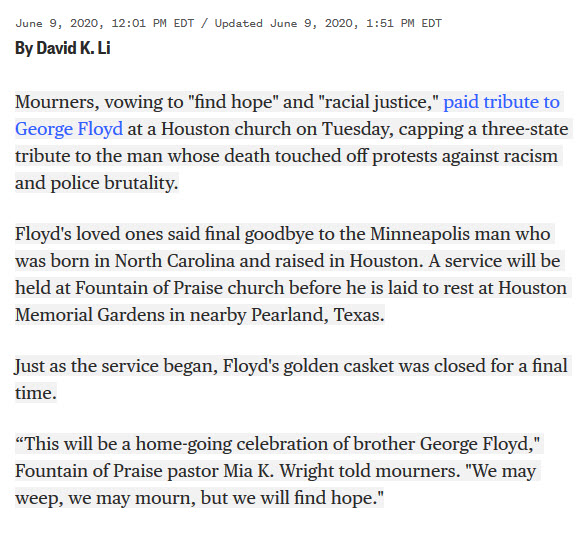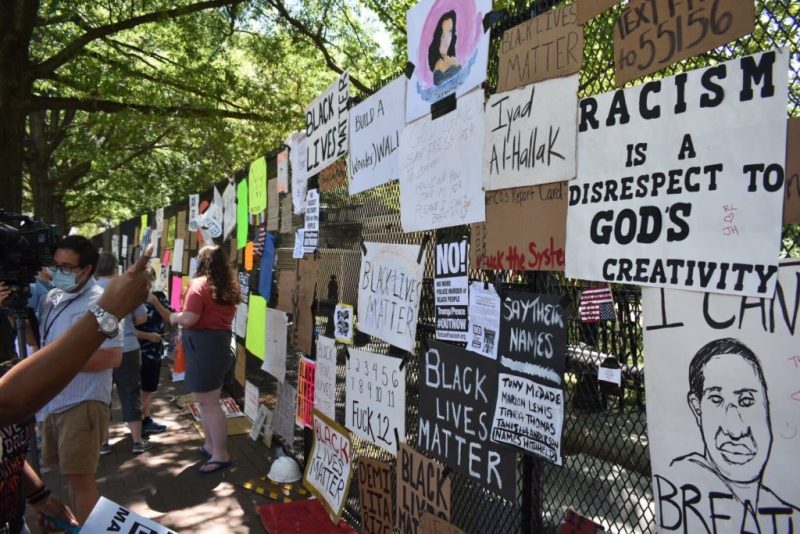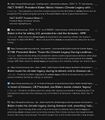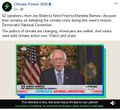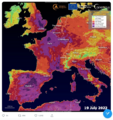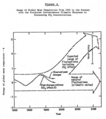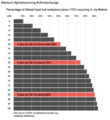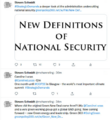Category:Social Justice: Difference between revisions
Siterunner (talk | contribs) No edit summary |
Siterunner (talk | contribs) No edit summary |
||
| Line 154: | Line 154: | ||
* https://www.strategicdemands.com/morning-after-screenshots-from-dc/ | * https://www.strategicdemands.com/morning-after-screenshots-from-dc/ | ||
································ | |||
Revision as of 15:41, 11 June 2020
Tuesday, June 9, 2020
- ························································································
After the Memorial Service of George Floyd
There's a street in Savannah called River Street. The street is paved and bumpy with paver stones laid there alongside the
Savannah River. Few know these days that River Street is slave ship ballast, rocks that slave ships carried in their hold with the slaves. Over the yrs thousands of ships carried European-enslaved Africans, and African rocks -- chert, basalt -- quartz to the Southern city of Savannah, purposefully built on a native American graveyard site by an Englishman named General Oglethorpe.
The Africans had made a stop at Tybee Island, along Lazzaretto Creek, a lazzaretto its called, a quarantine stop. The chained people in the hold were counted, their saleable qualities written in detail on bills of lading and offer, preparing them for sale on River Street.
After they were unloaded, the African men then unloaded the rocks. This gave the slave traders an idea of how they would work in the fields. Then the slaves were chained to metal hooks in stonework along the river. The hooks are still there, tho few know what those rusty hooks in walls alongside River Street in Savannah were for. What people do know is that Savannah is known for being a haunted city. Not just because of all the literature, 'the book' and the movie that came from it, Midnight in the Garden of Good and Evil, and all the hanging moss, the deep humid smells, the whispers in the trees, the talk of spirits roaming still.
My first trip to Savannah told me this was a place where I should be very aware when I walked the streets at night. There are souls wandering still in Savannah. Savannah has lessons to tell us and if we stop and listen, we can hear them.
Stop and Listen
An old friend who used to edit at Roll Call and E&E Environment & Energy sent this to me. A June 9th editorial from his new venture, Maryland Matters.
Maryland does matter, as does its history, up the coast a bit from Georgia and split by pre Civil War Mason-Dixon line. The Province of Maryland saw the slavery line became a reality in 1767. Stones were placed every mile to mark the line between free and slave. Many of these original stones, rocks in the ground where on one side one could be free, in a manner of speaking, and on the other side, one could be owned and enslaved.
Let's look closer at the 'free' side in Maryland. Josh Kurtz and Maryland Matter lays it out for us. It's in the law, law and order of that time with the echoes still with us.
Read it slow, stop and listen to the voices:
Tucked between an early wrongful death statute titled “Negligence” and an article governing “Notaries Public,” sits Article 66 of the Maryland Code of 1860. Titled “Negroes,” Article 66 lays out the laws governing black life in the state of Maryland on the eve of the American Civil War across approximately 20 pages.
It is an example of one American state’s most fully formed corpus of law on the Black body. It is also an example of the American legal tradition of sanctioning and incentivizing the killing of black men by white citizens and law enforcement, a legacy reverberating in the recent murders of Ahmaud Arbery and George Floyd.
At the core of Article 66 is the impossibility of Black personhood, and this impossibility is achieved, in large part, by establishing a system of White control over the Black body. The article begins with the pronouncement that “Negroes have been held in slavery” in Maryland from its earliest settlement, and that “every owner of such negro is entitled to his service and labor for the life of such negro.” (Article 66, sec. 1).
This makes clear that there is no distinction between slave and Black person (“negro”), and that the power of Whites over Black bodies is perpetual. Later in the document (sec. 42), Article 66 prohibits the freeing of slaves by deed or last will and testament, meaning slaves could not be freed upon the death of their owner. This helped preserve the legal identity of the slave as property rather than person.
It is clear from Article 66 that this legal identity imposed on the Black body was enforced by conscripting White citizens into its enforcement. For example, section 47 required “All sheriffs and constables,” who then would have been White, to arrest any free Black person in the State from outside of Maryland, who were not allowed to enter the state (sec. 44).
But Article 66 also extended that same power to “all other [White] persons” who were also “authorized to arrest any such free negro” (sec. 47). White persons were not only authorized to arrest any free Black person from outside the state, they were entitled to half the $500 fine (in 1860) in the instance they arrested a free Black person for illegally entering Maryland a second time (sec. 44).
Thus, White persons were not only endowed with absolute authority over the bodies of “free” Black persons from outside Maryland, they were economically incentivized to exercise that authority and make White power over the Black body real. This economic incentivizing of the exercise of White power over the Black body is found throughout Article 66. (E.g., sec. 9, 46, 67-68, 70, 73).
Article 66 also encouraged White violence (read: use of force) against Black persons. For example, sec. 72 of Article 66 prohibited free Blacks from owning dogs without a permit, and the permit had to be renewed annually. The same section also authorizes “any person [to] kill any dog kept contrary to this section.”
In other words, any White person, upon the expiration of a Black person’s dog permit, had the legal right to kill that dog solely on that account. This is nothing other than the codification of an act of wanton cruelty against Black persons and families.
The greatest incitement to violence, however, rests in sections 3-11. Section 3 states that, “Any person may arrest any runaway negro, and carry him before a judge or justice.” Further, anyone attempting to do so was granted immunity for any use of force employed in the attempt:
“If any runaway slave shall resist the person who attempts to arrest him, and such slave happens to be slain for refusing to surrender himself, such killing shall be deemed justifiable; and any slave so killed shall be paid for by the State.” (sec. 11).
No other provision of Article 66 better contextualizes the rage currently being felt over the deaths of Black men at the hands of the State and their agents, many often White. How often has “resisting arrest” been used as a justification to murder a Black person? Here is its provenance in American law.
How often have we heard that the killing of a human being was justifiable because she resisted arrest? Here is its provenance in American law.
The Statues 'Honoring the Confederacy'
The memories from the past flow past us, a river of time in the South, the land of the 'Confederacy', the war to keep slavery a fact.
Here in Florida, where your writer resides, the ghosts of the past live in the present. Today, Confederate flags can be seen daily. Driving down the roads are Dixie flags in truck beds and rear windows, often displayed, if the words are said out in the open, by folks who believe still in 'the cause', the Southern cause in the Civil War.
Here in Florida, next to Georgia, not far from Savannah, the memories of slavery remain embedded in the land. Stone monuments to rebel troops, leaders and battlegrounds with places of 'honor' in our cities. Slavery's vestiges are still venerated, displayed and given salutes by some. But this is changing. The flow of time is bringing change, a new era even as those who honor the old ways call for another hurrah, another rebel yell.
But yesterday, June 9th, 2020, the tallest, historic Confederate monument was removed in the dark of night in Florida's largest city -- Jacksonville.
It happened in Hemming Plaza in the center of Jacksonville, the city named after the slayer of Indians, the seventh president of the United States known for slaughtering and removing the Native American tribes remaining in the South and marching them to reservations beyond the Mississippi River.
Andrew Jackson was celebrated for opening up 25 million acres of native peoples land to white settlement, in violation of treaties but there is was -- a slaughter in the name of 'civilization'. Their skin was dark, they had to go. They were 'savages'. They were hated. The Indian wars and white man plagues wiped out millions of the original people. Andrew Jackson led the troops against the Creek tribe. "We shot them like dogs," Davy Crockett is reported as saying in the news reports.
Three tribes had 21 million acres taken by Jackson who proclaimed to the US Congress, “They have neither the intelligence, the industry, the moral habits, nor the desire of improvement which are essential to any favorable change in their condition. Established in the midst of another and a superior race…they must necessarily yield to the force of circumstances and ere [before] long disappear.”
The U.S. Army removed 60,000 Indians. The removal and forced march was known as the “Trail of Tears.”
Today, in Andrew Jackson's city, Jacksonville, questions are being asked about how far the mayor who ordered the removal of the towering Hemming granite stone monument to the war for slavery.
What about the other Confederate monuments? Will they be removed too from their places 'of honor' in parks and be removed to museums and places where they will be regarded as historical artifacts with lessons to be learned about American past.
Or will the Jacksonville mayor go another way?
Today it was announced that Jacksonville looks to be the chosen site of the 2020 Republican convention. The US president decided, it's now being reported, that Florida is in, North Carolina is out. The long-planned convention in the Carolinas is being pulled as the North Carolina Governor was unwilling to give the president a demanded full-audience, no restrictions event in contravention to public health care experts warning against the spread of the Coronavirus, Covid-19.
And so it goes.
It used to be said that the powerful, the victors in war, write the history. To an extent, this has been shown to be true over the decades and centuries past.
Yet, there is another river of time, a River Street on which we are all traveling. It flows with its own force, it is a powerful force, moving, rippling, creating waves, eddies, currents.
The dynamic is happening here, today, with George Floyd, with the people rising up and saying 'let us breathe'. These are new times on River Street. We remember the old times. And we're learning.
~
GreenPolicy360
June 10, 2020
··············································
Saturday, June 6, 2020
Hundreds of thousands of people across the United States—and, in stunning displays of solidarity, around the world—poured into the streets Saturday demanding an end to police brutality and racial injustice in the largest day of demonstrations since the killing of George Floyd at the hands of Minneapolis officers last week.
Enormous and diverse crowds of demonstrators marched in the streets of Washington, D.C., Philadelphia, Chicago, and other major cities in a striking display of non-violent mass action. Participants in the historic demonstrations voiced hope that the remarkable energy behind the protests can be transformed into a sustained movement for change. (Via Common Dreams)
····················································································································
The Wars Come Home: Dissent and Discord in the US
Nationwide Demonstrations, a President's Threats
Washington Post / June 3 / Pentagon chief says he does not support the use of active-duty military forces to quell unrest, breaking with Trump
Repurposed from the Battlefields, Transferred to US Law Enforcement Agencies
Morning After Screenshots from DC / On June 2, 2020
································
June 10 / Update & Apology
‘I should not have been there,’ Gen. Milley says of Trump photo op.
The country’s top military official apologized on Thursday for taking part in President Trump’s walk across Lafayette Square for a photo op after authorities used tear gas and rubber bullets to clear the area of peaceful protesters.
“I should not have been there,” Gen. Mark A. Milley, the chairman of the Joint Chiefs of Staff, said in a prerecorded video commencement address to National Defense University, reports Helene Cooper. “My presence in that moment and in that environment created a perception of the military involved in domestic politics.”
His first public remarks since Mr. Trump’s photo op, in which federal authorities attacked peaceful protesters so that the president could hold up a Bible in front of St. John’s Church, are certain to anger the White House, where Mr. Trump has spent the days since the police killing of George Floyd in Minneapolis taking increasingly tougher stances against the growing movement for change across the country.
• #SocialJustice #EconomicJustice #ClimateJustice •
~
Subcategories
This category has the following 10 subcategories, out of 10 total.
A
E
P
V
W
Pages in category "Social Justice"
The following 66 pages are in this category, out of 66 total.
C
E
- Eco-economic Decoupling
- Eco-nomics
- Environmental full-cost accounting
- Environmental Justice
- Environmental Law, Rollbacks under Trump 2016-20
- Environmental Laws and Modern Environmental Movement
- Environmental movement
- Environmental Protection Agency
- ESA Living Planet Announcement - May 2022
- European Union Green Deal - Fit for 55
G
- GDP+
- Generation Green
- Glasgow Climate Summit - Pledges, Promises, Declarations - What's Next Up
- Going Green
- Google Earth Timelapse
- Green Bank in Maryland - and More
- Green Futurist Literary Writers
- Green Institute
- Green New Deal
- Green Party
- Green Politics 360
- Green Quotes
- Green Stories of the Day
- Green Stories of the Day - GreenPolicy360 Archive
- GreenLinks
- GreenPolicy360 Archive Highlights 2013
- GreenPolicy360 Archive Highlights 2014
- GreenPolicy360 Archive Highlights 2015
- GreenPolicy360 Archive Highlights 2016
- GreenPolicy360 Archive Highlights 2017
- GreenPolicy360 Archive Highlights 2018
- GreenPolicy360 Archive Highlights 2019
- GreenPolicy360 Archive Highlights 2020
- GreenPolicy360 Archive Highlights 2023
Media in category "Social Justice"
The following 200 files are in this category, out of 421 total.
(previous page) (next page)- 2020 record temperatures.png 800 × 502; 358 KB
- 7-20-2020 GreenPolicy360 RT No.2.jpg 591 × 510; 125 KB
- A Planet Citizen View.png 799 × 1,241; 1.64 MB
- A scorching year, what about the 360 warming data.jpg 600 × 706; 106 KB
- Acceptance on behalf of the United States of America.png 448 × 306; 62 KB
- Accessory Dwelling Units - Images varied-2.png 607 × 300; 329 KB
- Act now for a livable future.png 501 × 275; 272 KB
- Acting to make a positive difference - in St Petersburg Florida.png 600 × 723; 645 KB
- ADU 4-Tampa Case Study.png 682 × 806; 905 KB
- American Jobs Act compared w THRIVE Act (Green New Deal).jpg 674 × 798; 90 KB
- AOC re climate task force - july 8 2020.jpg 585 × 203; 38 KB
- Are Tiny Homes a Solution to the Housing Crisis.png 443 × 336; 286 KB
- Are Tiny Homes a Solution.png 408 × 303; 93 KB
- At Independence Hall - Sept 1, 2022.png 400 × 638; 416 KB
- Atmosphere Science.jpg 800 × 600; 45 KB
- Atmospheric Experiment of Humanity.jpg 519 × 574; 201 KB
- Banking - finance - climate - Mann-1.jpg 452 × 640; 162 KB
- Banking - finance - climate - Mann-2.jpg 452 × 640; 164 KB
- Battle for Democracy.jpg 640 × 123; 24 KB
- Bell hooks - when we love the earth.jpg 480 × 517; 128 KB
- Bernie Sanders, Senate 2.PNG 800 × 517; 379 KB
- Bernie Sanders, Senate Aug 3.PNG 800 × 518; 388 KB
- Beyond ludicrous politics in Florida March2015.png 761 × 251; 30 KB
- Biden - clean energy ambitions.JPG 640 × 334; 31 KB
- Biden introduces leadership team - Nov 24 2020.jpg 800 × 644; 173 KB
- Biden selects Kerry as special climate envoy.jpg 592 × 505; 87 KB
- Biden urged to act - Oct 18 2021 - The Guardian.png 663 × 600; 497 KB
- Biden's assembled an all-star climate team 4-21-2021.jpg 682 × 732; 309 KB
- Biden-Harris, CNN News Online - Nov 8, 2020.jpg 800 × 484; 114 KB
- Biden-Sanders Unity Task Force on Climate.jpg 701 × 780; 139 KB
- Big Oil Rocked by News May 27 2021.jpg 639 × 600; 84 KB
- Biggest climate related legislation in history - 1.png 800 × 188; 68 KB
- Bill McKibben to next generations.JPG 700 × 700; 203 KB
- Bill Nelson on Global Temp Rise and Climate Change.png 640 × 353; 100 KB
- Bill Nye The Planet's on Fire.jpg 800 × 675; 106 KB
- Bioneers 2023 - ThirdAct.Org.jpg 624 × 600; 145 KB
- Bioneers Conf 2021- Buckminster Fuller Instit joins.png 469 × 586; 599 KB
- Bioneers It's all connected - 30th annual conference.jpg 527 × 521; 79 KB
- Black Lives Matter - St. Pete FL.jpg 800 × 806; 174 KB
- Bloomberg Carbon Clock 10-26-2021 8-47-05 AM EST.png 800 × 195; 356 KB
- Blue Marble photo taken by the crew of Apollo 17 (1972).jpg 642 × 605; 129 KB
- Boxabl - The Casita.png 618 × 539; 246 KB
- Breakpoint - Reckoning with America's Environmental Crisis.jpg 329 × 500; 49 KB
- Breathing masks.jpg 800 × 531; 99 KB
- Bucky Trimtab.jpg 348 × 336; 88 KB
- Burst of climate denial as Trump presidency ends.jpg 632 × 604; 92 KB
- Car heating and cooling.png 465 × 635; 261 KB
- Carbon Brief - Greenhouse gas levels 2021.png 640 × 436; 292 KB
- Carbon Footprint - BP-McKibben-Solnit-Aug2021.jpg 516 × 264; 66 KB
- Carbon-footprint.jpg 297 × 516; 59 KB
- Caribbean Sea hot - June night 2024.png 676 × 600; 386 KB
- Casey Camp-Horinek.jpg 606 × 650; 132 KB
- CFSV2 world temp July 3, 2023.png 600 × 800; 513 KB
- CH4 graph - 1980-2020.JPG 640 × 446; 22 KB
- Changes in carbon dioxide per 1000 years - via Climate Central.jpg 682 × 424; 34 KB
- Check in.png 522 × 417; 193 KB
- Citizens Climate Lobby - Save Our Future Act 2021.jpg 518 × 262; 77 KB
- Climate action isn't 'bunny hugging' says Boris.jpg 800 × 264; 95 KB
- Climate activist - Steven Schmidt - 1978 on.png 600 × 480; 174 KB
- Climate Books - 2020.jpg 800 × 450; 69 KB
- Climate cases on the rise - Nature, Sept 2021.png 800 × 562; 181 KB
- Climate Change COP27 - Nov 11 2022 US Representatives.jpg 712 × 444; 54 KB
- Climate Change COP27 - Nov 11 Kathy Castor.jpg 712 × 710; 77 KB
- Climate Change Laws - database collaboration.png 640 × 271; 76 KB
- Climate Change Laws of the World - database.PNG 768 × 845; 383 KB
- Climate Change Litigation Databases Climate Law.png 800 × 330; 73 KB
- Climate Change US EPA.jpg 600 × 703; 95 KB
- Climate Conferences 1979-2020.jpg 768 × 768; 121 KB
- Climate Crisis and the Global Green New Deal.jpg 293 × 418; 33 KB
- Climate Desk.jpg 390 × 226; 21 KB
- Climate Emergency Institute - Oct 2022.png 610 × 600; 274 KB
- Climate Emergency Institute -- 2021.jpg 800 × 450; 55 KB
- Climate emergency.jpg 800 × 450; 69 KB
- Climate Headline News around the World - July 2023.jpg 600 × 704; 151 KB
- Climate Legacy of Biden.jpg 600 × 687; 265 KB
- Climate Migration Interactive Map.jpg 766 × 719; 58 KB
- Climate News - Oct 28 2022.jpg 626 × 600; 88 KB
- Climate News - United Nations Report - Feb 2022.png 768 × 878; 539 KB
- Climate News Dec 4 2023 in Dubai.png 800 × 1,037; 649 KB
- Climate Plans Enforcement - Resources - GreenPolicy.png 768 × 897; 686 KB
- Climate poll - Florida.png 640 × 267; 36 KB
- Climate strike - Week 171.png 739 × 600; 834 KB
- Climate Strike.jpg 560 × 387; 56 KB
- Climate Summit - Leonardo DiCaprio.png 600 × 663; 521 KB
- Climate Summit live updates - Nov 2 2021.png 751 × 600; 420 KB
- Climate Summit planned-1.jpg 800 × 301; 53 KB
- Climate Summit planned-2.jpg 800 × 187; 31 KB
- Climate Summit planned-3.jpg 800 × 278; 44 KB
- Climate Summit planned-4.jpg 800 × 241; 41 KB
- ClimateNewsFlorida.jpg 448 × 191; 36 KB
- CO2 cumulative emissions 1850 - 2021 - countries.jpg 640 × 462; 211 KB
- CO2 global pathways via IPCC AR6 - how will we respond.jpg 800 × 450; 57 KB
- COP26 Climate Summit concludes.jpg 600 × 800; 160 KB
- COP26 concludes - 2.png 648 × 467; 177 KB
- COP26 concludes - 3.png 648 × 713; 416 KB
- COP26 concludes.png 648 × 528; 329 KB
- COP26 in GLASGOW - 31 OCT-12 NOV 2021.jpg 800 × 264; 51 KB
- COP27 'opening speech'.png 640 × 460; 160 KB
- COP28 News - Dec 13 2023.png 800 × 898; 410 KB
- Coral bleaching - August 2023.png 488 × 430; 261 KB
- Coral bleaching - NOAA - August 2023.png 488 × 338; 201 KB
- Corita - Jerry Brown - Rule 7.png 800 × 453; 289 KB
- Corita action.jpg 410 × 342; 42 KB
- Cradle of Civilization - and climate change.jpg 640 × 360; 70 KB
- Dated record of Earths climate - Science Report Sept 10 2020.jpg 735 × 669; 192 KB
- Death Valley ... the heat, what its like.jpg 640 × 381; 62 KB
- Democratic National Convention-62 climate speakers.jpg 443 × 407; 57 KB
- Democratic Party Climate Bill - Aug 2022.png 640 × 269; 70 KB
- Diversity in Hollywood.png 777 × 493; 577 KB
- Diversity in Hollywood2.jpg 777 × 493; 64 KB
- Earth Day 2021 - Climate Summit News-1.jpg 491 × 270; 127 KB
- Earth Day 2022 - Act up.png 457 × 370; 155 KB
- Earth Emoji.png 50 × 50; 2 KB
- Earth grassroots.jpg 374 × 238; 32 KB
- Earth in Human Hands.jpg 325 × 385; 34 KB
- Earth in Our Hands.png 76 × 76; 5 KB
- Earth Summit 1992-s.png 336 × 418; 283 KB
- Earth Summit 1992.jpg 600 × 746; 171 KB
- Earth trapping unprecedented amount of heat - NASA.jpg 468 × 373; 56 KB
- Earth-upper-atmosphere-NASA.jpg 800 × 781; 327 KB
- Earths rotation as we roll thru space.jpg 800 × 529; 69 KB
- EarthScience Missions via the EOS - 2022.png 800 × 219; 139 KB
- EleanorRooseveltHumanRights.png 535 × 423; 60 KB
- Energy - Electric Measuring and Monitoring.png 715 × 1,978; 862 KB
- Energy Charter Treaty.jpg 512 × 480; 74 KB
- Environmental laws in US - Supreme Court votes soon.png 800 × 414; 334 KB
- Environmental Protection Agency logo.png 380 × 414; 39 KB
- EPA and the Green Bank - Feb 2023.png 476 × 542; 244 KB
- ESA Living Planet Symposium - Announcement.png 637 × 600; 508 KB
- ESA Living Planet Symposium - May 2022.png 700 × 600; 258 KB
- ESG Fight - Feb 2023.png 396 × 194; 88 KB
- Estuary in Clearwater on Tampa Bay.jpg 3,584 × 2,016; 1.5 MB
- EU agrees to cut emissions 55 percent by 2030.jpg 800 × 558; 96 KB
- EU unveils new climate change policy - July 14 2021 - 1.jpg 800 × 234; 33 KB
- EU unveils new climate change policy - July 14 2021 - 2.jpg 800 × 552; 86 KB
- EU unveils new climate change policy - July 14 2021 - 3.jpg 800 × 549; 89 KB
- EU unveils new climate change policy - July 14 2021 - 4.jpg 800 × 550; 92 KB
- EU unveils new climate change policy - July 14 2021 - 5.jpg 800 × 548; 88 KB
- EU unveils new climate change policy - July 14 2021 - 6.jpg 800 × 557; 89 KB
- EU unveils new climate change policy - July 14 2021 - 7.jpg 800 × 553; 92 KB
- EU unveils new climate change policy - July 14 2021 - 8.jpg 800 × 589; 91 KB
- Europe heat wave - July 19 2022 - via Copernicus satellite.png 600 × 639; 704 KB
- European Greens - Baerbock - Candidate for German Chancellorship.jpg 513 × 185; 37 KB
- European Greens EGPCongress Dec 2022.png 800 × 745; 640 KB
- Extreme temperature-world-May 2024.jpg 640 × 427; 105 KB
- ExxonMobil CO2 climatic response study - Graphic 1 - 1982.png 537 × 680; 150 KB
- ExxonMobil CO2 climatic response study - Graphic 2 - 1982.png 537 × 605; 112 KB
- Facts about US Energy Use.jpg 697 × 600; 101 KB
- FairVote.jpg 535 × 122; 14 KB
- Floating adaptations - GCA - for sea-level rise - circa 2023.png 600 × 732; 273 KB
- From 1968 to 1992 -- and the Journey continues....png 572 × 851; 320 KB
- George Floyd In-Memory.jpg 600 × 450; 68 KB
- George Floyd-2.jpg 594 × 362; 94 KB
- German foreign minister travels to India.png 640 × 178; 115 KB
- GHG forcings 1750-2020.png 531 × 531; 94 KB
- GHG ppt concentrations 1975-2020.jpg 640 × 361; 69 KB
- Ginsburg leaves a chasm on the Supreme Court.jpg 800 × 624; 92 KB
- Glasgow-Climate Conference News-Nov 6, 2021.png 600 × 800; 290 KB
- Glass Gem Corn.jpg 400 × 400; 21 KB
- Global Changes in temperature 1850-2020.jpg 480 × 480; 152 KB
- Global Climate Change textbook-Edition2.jpg 604 × 680; 96 KB
- Global climate conferences and GHG increases.jpg 793 × 801; 56 KB
- Global Climate Dashboard - NOAA - Climate.gov.png 630 × 480; 165 KB
- Global climate dashboard-NOAA climate.gov.jpg 521 × 221; 45 KB
- Global climate dashboard-www.climate.gov.jpg 800 × 489; 100 KB
- Global Climate Dashboard.jpg 800 × 529; 101 KB
- Global fossil fuel emissions - in a lifetime graphic.png 600 × 657; 233 KB
- Global greenhouse gas emissions - 1980 - 2020.png 640 × 480; 158 KB
- Global Stocktake, the first GST.jpg 800 × 905; 513 KB
- Global temperature change 1850-2016.gif 512 × 288; 1.38 MB
- Global temperature change 1901-2000.jpg 640 × 508; 47 KB
- Global temperature variations over past 200 years.jpg 640 × 360; 29 KB
- Global warming June 2024.jpg 640 × 174; 46 KB
- Google Earth Engine.png 448 × 165; 45 KB
- GP360 tagcloud2 m.png 531 × 324; 132 KB
- Green Branching Out.jpg 400 × 194; 35 KB
- Green Highlights.jpg 800 × 600; 121 KB
- Green Networking @GreenPolicy360.net.png 788 × 604; 764 KB
- Green New Deal - Strategic Demands - Oct 1, 2021.png 602 × 658; 245 KB
- Green New Deal in NYC.jpg 605 × 363; 53 KB
- Green Quotes - May 2022 - Green360.png 640 × 112; 46 KB
- Greeneuropeanjournal.eu.jpg 485 × 237; 30 KB
- Greenhouse gas levels hit record - Reuters.jpg 600 × 696; 104 KB
- GreenPartyPlatform 2000 KV10.png 338 × 531; 25 KB
- GreenPolicy360 - May- 9-2024.png 800 × 406; 119 KB
- GreenPolicy360 - May-10-2024.png 790 × 694; 320 KB
- Greens EU 2024.jpg 480 × 540; 91 KB
- Greta - the politics thats needed.jpg 639 × 203; 38 KB
- Greta anger into action.png 800 × 419; 528 KB
- Greta Looks Back.PNG 504 × 437; 368 KB
- Greta Thunberg - Week 203 Climate Strike Banner.png 209 × 127; 51 KB
- Greta Thunberg - Week 203 Climate Strike.png 554 × 601; 488 KB
- Hannah Arendt warns us.jpg 475 × 236; 20 KB
- Hannah Arendt.jpg 527 × 680; 51 KB

